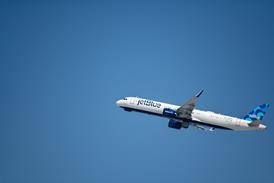For Eaton's aerospace operations, a doubling of revenues from $800 million to $1.6 billion in the past four years and a ninefold growth in sales from a decade ago comes as no accident.
The Irvine, California-based supplier of fuel, conveyance, hydraulic and electrical systems for aircraft set out four years ago to better integrate what had been silos of expertise within the company, where sales professionals and managers from the four business units competed for and managed programmes independently.
Directing the reorganisation was Bradley Morton, after being named president of Eaton's aerospace division in 2003, coming from the position of vice-president and general manager for Honeywell's Advanced Circuits division in Minnesota.
Unified presence
Morton's plan was to create a unified Eaton presence for customers and a balanced portfolio that would help the company compete for new projects as a systems integrator rather than a piece part supplier. Tasks included filling leadership roles within the company and creating a balance matrix, an organisational tool that links line managers with their responsibilities within the four business units. In parallel the company set out to bring in new companies that would enable it to become a total systems provider in each of its four product areas.
Acquisitions included FR-HiTemp and Stanley Aviation, divisions of Cobham, with expertise in low-pressure airframe fuel systems, electromechanical actuation, air ducting and hydraulic power and fluid distribution systems for fuel, hydraulics and air. Next came PerkinElmer's aerospace division, which makes sealing and pneumatic systems for large commercial aircraft and regional jets. The most recent addition, Argo-Tech, brought the ability to provide fuel control systems that start with ground service and end at the turbine engines.
Acquisitions before Morton's tenure, including Aeroquip-Vickers in 1999, helped position the company for military work outside the USA through existing contracts, including systems for the Eurofighter.
Future growth is likely to focus on building Eaton's electro-mechanical and electrical services portfolio, says Robert Luley, the company's vice-president for programme management and technology. The first fully integrated package the company won was for hydraulic systems on Raytheon's Hawker 4000, formerly the Hawker Horizon, in 1999.
Native tongues
More recent wins under Morton's direction include multiple platforms for the Embraer Phenom 100 very light jet programme in 2005. Of the 10 proposals the company made, it won seven. The work is distributed among five manufacturing plants in the USA and managed at the customer's doorstep - in São José dos Campos, Embraer's headquarters in Brazil. The company later won a contract to supply systems for Embraer Phenom 300 light jets. Co-locating a programme manager who speaks the native tongue with the customer proved to be a winning combination for the company's Airbus A380 work package in 2002, and has now become the company's credo under Morton.
In July Eaton won work packages on Sikorsky's new CH-53K helicopter. It bid for three elements - fuel, fluid conveyance and hydraulics power generation systems - and so far has won the hydraulics and fluids elements.
To focus on its low-cost strategy and boost competitiveness, Eaton has engineering staff in India and manufacturing staff in plants in Tijuana, Mexico, where the company will have 700 employees by year's end, and in Batam, Indonesia. Like many companies, Eaton is also seeking to do more sourcing in China, India and eastern Europe.
Source: Flight International























